Popular na sua indústria






Máquina de reciclagem de garrafa de plástico, máquina de reciclagem para pet, esfregador, secagem, reciclagem, garrafa, pet, frascos, máquina de reciclagem de lavagem quente
€ 50.007,73 - € 64.824,83
Pedido Mínimo: 1 Conjunto






Factory Direct Plastic Crushing Shredder Machines PE PP PVC PET Plastic Recycling Crusher Grinder Machine
€ 554,72 - € 1.389,11
Pedido Mínimo: 1 Peça
Envio por peça: € 13.080,73







Best Price Plastic Grinder Price Recycling PE PP PVC PET Waste Plastic Shredder Grinding Machine Crusher
€ 416,74 - € 509,34
Pedido Mínimo: 1 Peça
Envio por peça: € 13.080,73







Quality Choice Pet Plastic Lavagem e Esmagamento Reciclagem Linha Máquina para Resíduos Plásticos Reciclagem
€ 18.521,38 - € 46.303,45
Pedido Mínimo: 1 Conjunto
Envio por peça: € 463,04







Triturador de alta potência personalizado Triturador reciclado para plástico e grãos
€ 576,95
Pedido Mínimo: 1 Peça







Linha de reciclagem de lavagem de filme PE PP para garrafas PET de plástico
€ 55.564,14 - € 74.085,52
Pedido Mínimo: 1 Conjunto





OUNAISI Fábrica Vendas Diretas PET PVC Garrafa Resíduos Reciclagem Triturador De Plástico Único Máquina Com Preço Baixo
€ 563,98
Pedido Mínimo: 1 Peça
Envio por peça: € 463,04






Resíduos Lump Plastic Runner Shredder 30-200L Garrafa PET Triturador De Corte Máquina De Triturador De Plástico
€ 1.389,11 - € 4.121,01
Pedido Mínimo: 1 Conjunto






15HP Garra Tipo Triturador De Plástico Máquina Triturador De Garrafa PET Máquina De Esmagamento De Plástico
€ 926,07 - € 4.028,41
Pedido Mínimo: 1 Conjunto






Máquina esmagadora de garrafas de plástico para resíduos, máquina esmagadora de plástico
€ 1.676,19
Pedido Mínimo: 1 Conjunto






China fábrica usada pvc resíduos de plástico duro barril filme pet garrafa reciclar esmerilhador máquina trituradora preços
€ 1.389,11 - € 1.481,72
Pedido Mínimo: 1 Conjunto






Triturador de resíduos sólidos, alta eficiência, máquina pequena de madeira, plástico, garrafa de pet, máquina trituradora
€ 925,15 - € 2.869,89
Pedido Mínimo: 1 Conjunto
Principais categorias
Sobre pet garrafa triturador máquinas
Alibaba.com oferece 24908 produtos de pet garrafa triturador máquinas.Há uma vasta variedade de opções de pet garrafa triturador máquinas disponíveis para você, como para animais de estimação, plástico e pe. Você também pode escolher entre rússia, india e méxico pet garrafa triturador máquinas. Assim como fabricação planta, construção e lojas de material de construção pet garrafa triturador máquinas. E com a opção de ter o pet garrafa triturador máquinas motor,rolamento ou engrenagem.








